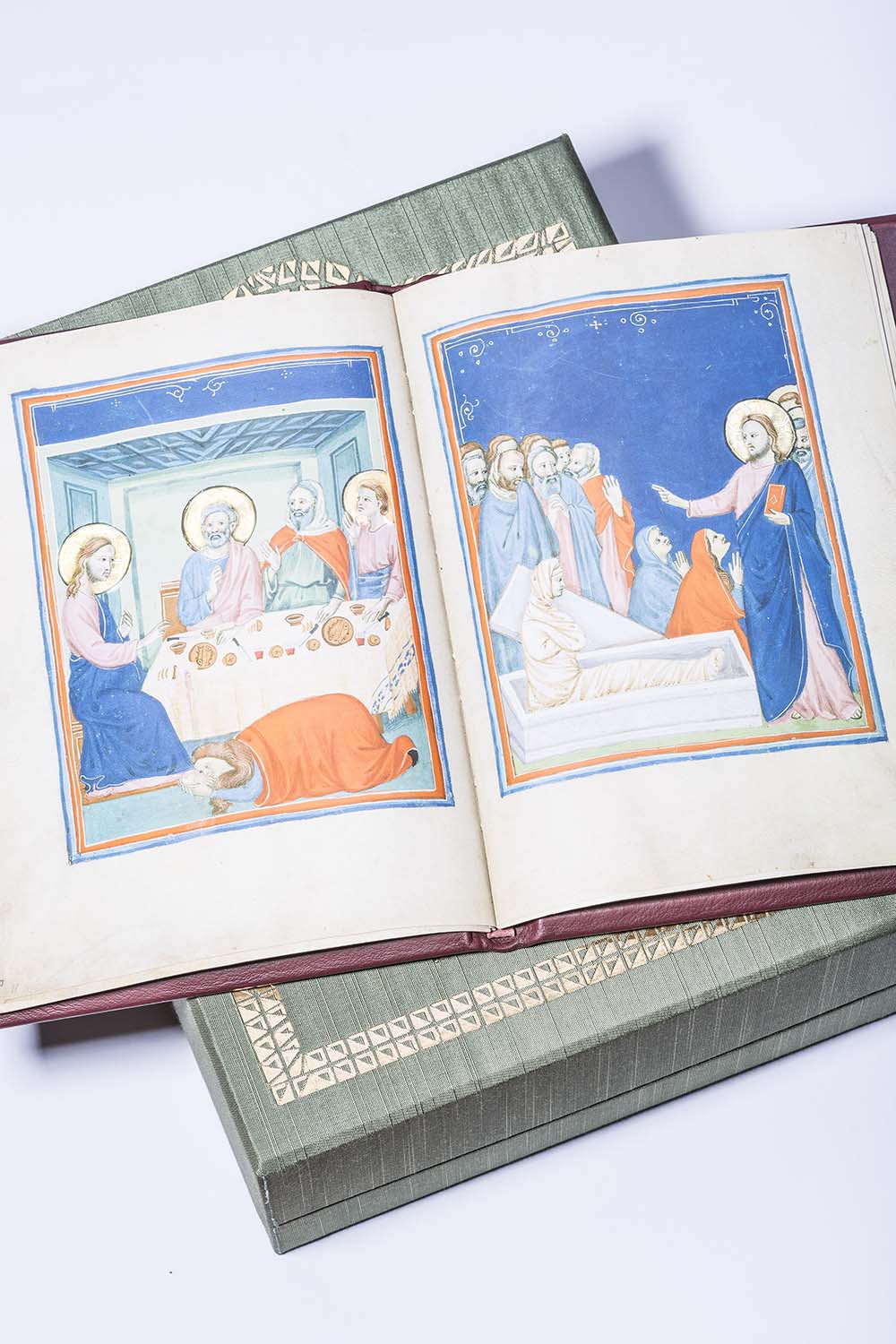Pacino di Bonaguida’s
Picture Book
Brilliant Florentine miniatures about the life of Christ
A masterpiece at the dawn of Renaissance
Pacino’s masterly representations captivate through their incredible freshness of the colours as well as the clear iconography that is never overloaded. The influence of the great Giotto becomes evident by the adoption of some striking stylistic features. Representations from the Old Testament accompany Christological and hagiographic scenes, similar to introductory cycles of psalters, especially of French origin. The foundation of this iconography was laid by Italian translations of “La Somme le Roi” of the Dominican priest Frère Laurent. This text contains almost everything that contains a breviary for laymen.
Part of the manuscript is dedicated to the life of Blessed Gerard of Villamagna who was venerated especially in the region of Florence. Only in one description from the 17th century, scenes are preserved that were originally mounted on an altar dedicated to him, and that correspond more or less to the scenes represented in the manuscript. This could be an indication that this mysterious manuscript belongs to a cycle of manuscripts called “libelli”: illustrated vitas of Saints closely linked to the shrine or relics of the Saint.

Pacino di Bonaguida and the “Miniaturist Style”
Pacino was the first to include the spatial concept of Giotto in the miniature painting – and he was the first illuminator of Florence who is still known to us by name. One of his special qualities was to develop independently scenes without referring to direct examples. He proves his originality not only in this outstanding work, but also in other masterpieces that prove his inclination towards unusual solutions for the requests of his customers, like for instance the Tree of Life in the Florentine Academy or the Chiarito Tabernacle which is located today in the Getty Museum in Los Angeles.
The so-called Miniaturist Style distinguishes the masterpieces of a group of artists led by Bonaguida from the monumental works of Giotto. Both are based on the developments of the Trecento with all its progressiveness.
Due to the natural limitation of the scenes in the miniatures, the artist basically needs to capture one instant – however this instant is accomplished so artistically that, in a way, the further story imposes on the observer and, as a result, an incredibly dynamic picture emerges. Thus, Bonaguida established a new way of narrative development in the illumination of books. The fantastic Picture Book of Pacino di Bonaguida is undoubtedly one of the most important works of the European history of art at the dawn of the Renaissance.
A fascinating kaleidoscope of the Italian Trecento
The art of the Italian Trecento – especially the outstanding Giotto – contributed essentially to the development of the occidental art. From this significant stage originates this picture book completely without text that represents scenes of the life of Christ completed in highest perfection by Pacino di Bonaguida (around 1280–1340). With it, the trendsetting spatial concept of the Trecento was introduced for the very first time in the illumination of manuscripts – a milestone in the history of art.
On 19 folios, a total of 38 full-page miniatures unfold a rich sequence of pictures of late medieval art in tempera and gold leaf. Herewith, the Trecento shows itself in artistic perfection; what Giotto created with his frescos in the Arena Chapel can be found at the same level of quality, but on a smaller scale, in this unique illuminated manuscript.
32 full-page pictures show scenes of the life of Christ. Enclosed to this corpus, we find two scenes from the Old Testament and four scenes of the life of Blessed Gerard of Villamagna. So, the spectrum spans from the Old Testament and the New Testament to the history of Florence in the 13th century.
Pacino di Bonaguida
“The Giotto of book illumination”
Pacino di Bonaguida is one of the precursors of the art of the Renaissance. His works are without exception superb.
Nevertheless, one in particular stands out: his Picture Book with scenes from the Life of Christ designed and realised completely without text. This unique work of arthistorical significance now will do justice to its importance for the first time and it will be presented to a more broad public: as a perfect facsimile edition true to the original of the manuscript M.643 from The Morgan Library, New York, originated around 1320/30 in Florence.


 No products in the cart.
No products in the cart. 
